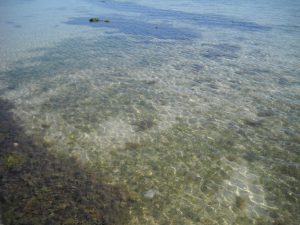For those who are not sure what “salinity” is – it is the amount of dissolved solids (salts) in water -how salty the water is. It is typically measured in parts per thousand (ppt or ‰). Seawater is usually around 35‰. Brackish water is salty, but not as salty as the sea. And then there is freshwater which would be around 0‰.
Some creatures, like mullet and manatees can tolerate a wide range of salinity (oceans to rivers) and are termed euryhaline. Most others have a smaller salinity range and are termed stenohaline. Two of those are seagrass and scallops.
Over the last 50 years there has been a decline in both seagrass and scallops in the Pensacola Bay System. Scallops are all but gone, a few show up once in a while. There are numerous reasons why species decline, and those reasons (stressors) need to be addressed before any form of restoration will be successful.
Over the past few years, the Pensacola Bay System has experienced higher than normal rainfall. Mean rainfall for the area is around 61 inches. Since 2010 the mean rainfall is 71.58”1. Each year the amount has been at or above 61” and two years (2017 and 2018) we were at 91 and 90” respectively. The last decade has been wetter.
With an increase in impervious surfaces covering the landscape, excessive rainfall means excessive run-off into local waterways. This increase in freshwater should reduce the overall salinity.
The two major seagrass species in the lower portion of our bay are shoal grass (Halodule wrightii) and turtle grass (Thalassia testudinum). These seagrass meadows are important for many commercial, and recreational important marine/estuarine species – including bay scallop (Argopecten irridians). There are many stressors contributing to the decline of these seagrass meadows, but could reduction of salinity be one?
Shoal grass actually has a wide tolerance for salinity change and seems to adapt well to changing conditions. Mazzotti (et.al.)2 indicated they can survive salinities as low as 3.5‰ but prefers it higher. Turtle grass (the species bay scallop prefer) prefers salinities between 24-35‰. It has been suggested that the salinity for both the grasses, and the scallops, needs to be at, or above, 20‰. Hence the need to monitor salinity in our bay.
We currently have seven volunteers monitoring one of 15 stations. Each volunteer is asked to check the salinity once a week. They are sampling from the surface near shore and measuring with a refractometer. The project is designed to report salinities when each volunteer has completed 100 readings (weeks). We post seasonal updates (see spring 2021 below). Most stations have not reached the 50-reading mark yet, and some are no longer being monitored. Lower Perdido Bay has, and the salinities are too low to support shoal or turtle grass, nor would this be a suitable site for scallop restoration. Kees Bayou is not at 100 yet but the salinities are currently high enough. If you are interested in monitoring one of the sites with low readings, please contact me at roc1@ufl.edu.
| Body of Water | (n=) | Surface | ||||
| Mean | Median | Mode | ||||
| Bayou Grande | 29 | 20 | 21 | 21 | ||
| Navy Point SE | 4 | 14 | 12 | NA | ||
| Navy Point SW | 4 | 10 | 9 | 7 | ||
| Bayou Texar | 9 | 8 | 8 | NA | ||
| Bayou Chico | 5 | 9 | 5 | 5 | ||
| Big Lagoon | Grand Lagoon | 15 | 23 | 23 | 20 | |
| State Park | 7 | 18 | 15 | 14 | ||
| Big Sabine | 42 | 21 | 21 | 22 | ||
| Bruce Beach | 1 | 18 | 18 | NA | ||
| Kees Bayou | 87 | 20 | 20 | 14 | Good | |
| Little Sabine | 23 | 22 | 24 | 25 | ||
| Lower Perdido Bay | 100 | 16 | 15 | 20 | Low | |
| Old River | 36 | 23 | 23 | 25 | ||
| Sanders Beach | 24 | 18 | 19 | 20 | ||
| Shoreline Park | 1 | 18 | 18 | NA |

Photo: Leroy Creswell

Photo: FWC
1National Weather Service. https://www.weather.gov/mob/climate_kpns.
2 Mazzotti, F.J., L.G. Pearlstine, R. Chamberlain, T. Barnes, K. Chartier, and D. DeAngelis. 2007. Stressor Response Model for the Seagrasses, Halodule wrightii, and Thalassia testudinum. Final Report for Technical Assistance for an Ecological Evaluation of the Southwest Florida Feasibility Study. University of Florida IFAS. https://crocdoc.ifas.ufl.edu/publications/reports/Seagrass%20HSI%20Final%20report%20to%20SFWMD.pdf.
 0
0
